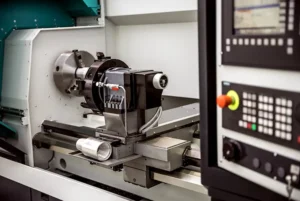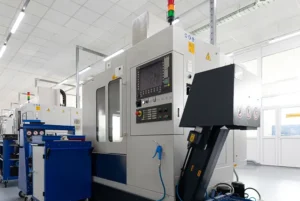What is a CNC Lathe Machine?
A CNC lathe machine is a computer-controlled manufacturing tool used to precisely cut, drill, and shape materials like metal, wood, and plastic. “CNC” stands for Computer Numerical Control, which means the machine interprets a digital design file to automate the entire machining process.
Instead of relying on manual input like turning cranks or adjusting levers, CNC lathes execute detailed instructions with unmatched consistency. This dramatically reduces errors and speeds up production.
The difference between a lathe and a CNC machine:
| Feature | Manual Lathe | CNC Lathe (CNC Machine) |
| Operation | Controlled by hand wheels | Controlled by software (G-code) |
| Skill Level Required | High (manual experience) | Moderate (programming knowledge) |
| Precision & Repeatability | Limited by human input | Extremely precise and consistent |
| Speed | Slower | Much faster |
| Complexity of Parts | Simple shapes | Simple to highly complex parts |
The Different Parts of a CNC Lathe Machine
To understand how a CNC lathe functions, it helps to break down its main components:
- Bed: The heavy, flat base that supports the entire machine and absorbs vibrations to ensure cutting stability.
- Headstock: Houses the motor and spindle, which spins the workpiece.
- Tailstock: Provides support for longer workpieces, especially during drilling or when working with flexible materials.
- Chuck: The clamp that holds and rotates the material during machining. Some CNC lathes feature hydraulic chucks for quick changes.
- Tool Turret: A rotating holder that switches cutting tools automatically based on programmed instructions.
- Control Panel (CNC Interface): Where the operator loads programs, monitors the process, and inputs commands.
- Carriage/Slide: Moves the tools along the X and Z axes, dictating the tool’s position relative to the workpiece.
These components work in harmony to produce precise parts quickly and repeatedly.
What Are the Different Types of CNC Lathe Machines?
CNC lathes come in several variations, each tailored for specific operations and part complexities:
1. 2-Axis CNC Lathe:
The most basic model, performing cuts along the X (diameter) and Z (length) axes. Ideal for producing straightforward cylindrical parts like rollers or shafts.
2. Multi-Axis CNC Lathe (3, 4, or 5 axes):
These machines allow for angular cuts, contouring, and drilling in multiple planes—perfect for complex geometries. Used heavily in aerospace, robotics, and automotive sectors.
3. Swiss-Type CNC Lathe:
Designed for high-volume, ultra-precise machining. The material moves while the tools remain stationary, minimizing deflection. Commonly used in watchmaking, electronics, and medical device production.
4. Slant Bed vs. Flat Bed Lathes:
- Slant bed: Allows for better chip flow and tool access—ideal for production environments.
- Flat bed: Offers higher rigidity and is better for heavier-duty parts and simpler operations.
5. Case Study:
A medical implant manufacturer switched to Swiss-type lathes and saw a 40% reduction in production time and improved tolerances on bone screws. The ability to machine long, thin parts without vibration was a game-changer.
How Accurate is a CNC Lathe Machine?
CNC lathes are renowned for their precision. Many achieve tolerances of ±0.001 inches (±0.025 mm), and high-end machines can go even tighter—down to microns.
What Affects Accuracy?
- Machine build quality: Stiff frames and precision-ground ways reduce vibration and backlash.
- Tool wear: Dull tools can throw off measurements and compromise surface finish.
- Environmental factors: Room temperature, humidity, and floor stability can subtly affect accuracy.
- Programming errors: Even a tiny mistake in the G-code can result in incorrect dimensions.
Maintenance tip:
Performing regular machine calibration and tool inspections is essential. For instance, setting a baseline test piece once a week can help you detect tool wear before it becomes a problem.
How Does a CNC Lathe Machine Work?
The process of CNC turning is highly systematic and relies on precise digital workflows. Here’s how it works:
1. Design the Part using CAD (Computer-Aided Design) software.
2. Convert the Design into G-code using CAM (Computer-Aided Manufacturing) software.
3. Upload the Program to the CNC controller.
4. Load the Material into the chuck and secure it properly.
5. Run the Program: The machine rotates the workpiece while the tool follows programmed paths to cut, shape, or drill.
6. Inspect the Output: Use gauges, calipers, or CMM (Coordinate Measuring Machines) to verify dimensions.
Example Tutorial:
Let’s say you’re machining a stainless steel flange. After designing it in CAD and generating the toolpath in CAM:
- Mount the round steel bar in the chuck.
- Upload the G-code.
- The CNC lathe first faces the end, then bores the center hole, finishes the OD (outer diameter), and cuts in key slots—all without intervention.
- Inspection confirms every piece is within 0.001-inch tolerance.
Uses of CNC Lathe Machines
CNC lathes are indispensable in various industries for creating both high-volume components and precision prototypes.
Industries and Applications:
- Automotive: Drive shafts, valve components, transmission housings
- Aerospace: Turbine parts, bearing cages, landing gear components
- Medical: Orthopedic pins, surgical instruments, dental abutments
- Electronics: Connector pins, camera housings
- Oil & Gas: Threaded pipes, casing collars
Real-World Example:
A bicycle manufacturer adopted CNC lathes to produce precision-machined gear hubs. The result? A 30% drop in production lead time and a more reliable final product. Since parts were consistent, fewer adjustments were needed during assembly.
Conclusion
CNC lathe machines have transformed modern manufacturing by making it possible to produce complex, high-precision components at scale. Their ability to operate autonomously and consistently makes them ideal for industries that demand accuracy and speed.
By mastering their parts, types, and workflow, manufacturers and machinists alike can unlock new levels of productivity and innovation. Whether you’re building a single prototype or running a full-scale production line, CNC lathes are the backbone of precision machining.




